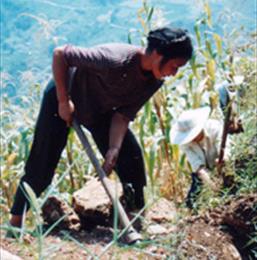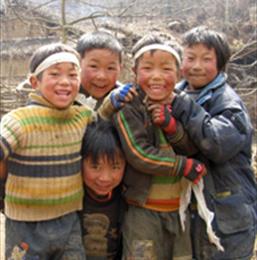Baikun Village,Ganluo 2001-2004
Lianghe Township is situated in Ganluo County, about 27 km from the county seat. It lies at an altitude between 1700-2200m above sea level. According to 2001 statistics, it is made up of 8 villages, 19 hamlets. The total number of households is 595 and the population is 2453. There is in total 6000 mu of agricultural land, or 2.5 mu per person. Average amount of grain per person is 400 kg.
Baikun Village
DORS has implemented projects in two villages in Lianghe Township, of which Baikun Village is one. Baikun is made up of 2 hamlets, one Han and one Yi. It is about a 20-25 minute drive from the township government (which is about an hour drive from the PAO office in Ganluo town). In total, it is about a 3.5 hour journey from Hanyuan, as the drive to Ganluo is about 2 hours.
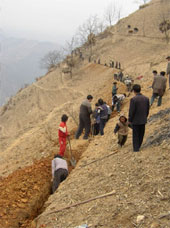 This village is separated into two hamlets with a combined population of 278 people. There is a road leading directly to the village so that there is not very much additional walking involved. On the road up the hillside, Hamlet 2 is first on the left, and is the lower half of the village. This hamlet is predominately Han, and is relatively better off than hamlet 1. Hamlet 1 is located on the higher ground, and conditions are noticeably poorer than hamlet 2. This is a primarily Yi hamlet. Despite the ethnic division, villagers claim that there is no tension between the two hamlets, and enjoy an amicable relationship.
This village is separated into two hamlets with a combined population of 278 people. There is a road leading directly to the village so that there is not very much additional walking involved. On the road up the hillside, Hamlet 2 is first on the left, and is the lower half of the village. This hamlet is predominately Han, and is relatively better off than hamlet 1. Hamlet 1 is located on the higher ground, and conditions are noticeably poorer than hamlet 2. This is a primarily Yi hamlet. Despite the ethnic division, villagers claim that there is no tension between the two hamlets, and enjoy an amicable relationship.
There is no paddy in the village, as they do not have enough water, though they do have an existing water supply system. Their land is quite spacious, and the village as a collective has contracted land that have not been divided to individual households, including a few thousand mu of grasslands available, though neither have been opened up nor used. The steepness of the land, however, makes it unsuitable for cultivation.
Picture: Digging a water-pipe trench in Baikun Village
Electricity Supply
The electricity project was undertaken at the request of the villagers, to replace an aged electricity system, built in 1974, which had fallen into disrepair. The former was owned and maintained by the villagers. However, because the generator was very old, it leaked oil and sparked. The wires needed replacing, and the old wooden telephone poles were rotten.
The Ganluo Water Conservancy Bureau drew plans for the proposed electricity project, and after consulting with the electricity company, estimated costs were drawn up. DORS staff approached some local officials, including the County Leader (Luo Hua), who agreed to see if it would be possible to include the two villages onto the Nongwang Gaizao scheme (a government-sponsored scheme to connect rural villages onto the central electricity grid). Ganluo County approved DORS’ request for the villages to be included in the Nongwang Gaizao scheme, which resulted in large savings of funds. The scheme provides most of the funds, but requires a total contribution of RMB 130 from each household to be connected. DORS helped the villagers to cover the cost by agreeing to pay RMB 100 of that sum. The households then contributed RMB 30 each.
62 households (210 people) in Baikun village benefited from the project. The Nongwang Gaizao contributed 76,619 RMB to connect Baikun village to the electricity grid. Two households in Baikun were too far removed from the main village, and so it would have been impractical to connect them to the grid. In order that they might not be excluded, and because the regulations of the Nongwang Gaizao stipulate that all households be included, two solar cell generators were purchased, after other options had been considered. The two solar generators cost 1450 (GBP 110.30) apiece, but so they could feel like everybody else, these households also contributed 30 yuan per household.
DORS’ successful application for the villages to be included in the Nongwang Gaizao scheme saved a lot of funds that were previously planned to improve the electricity in this village, which DORS was able to use in other areas of the Kadoorie integrated development project.
Total DORS contribution to Baikun and Zhongpu villages amounted to RMB 16,342, or GBP 1361.83. The total number of beneficiaries was 724 people in 191 households.
Fuel-Efficient Stoves
During the first village visit, fuel-efficient stoves were mentioned by the village leaders as a priority project. Most of the households still rely on fuelwood for stoves, and they are now not allowed to cut down trees for fuelwood from the reclaimed land. They were interested in building fuel-efficient stoves as they heard it would cut down on the amount of fuelwood they would use, but felt they didn't have the skills or the money to do this. Most of the households had a stove with one pot, as well as the traditional floor style stove where most of the cooking is done. 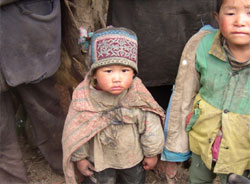
Photo: child with hat in Baikun
As some households were too poor to contribute financially in the first phase of the stove project, a second phase was planned. Villagers’ financial contribution was reduced to 30 RMB per stove, and those who had participated in the first phase did not take part. There were only 2 households who wanted to participate in the second phase and they put in 30 RMB each in August 2003.
The construction period began in April 2001 and ended in November 2003. All registered households have now completed stove construction. Of the 58 households in Baikun village, 39 households have benefited from this project.
The cost of the stoves was approximately 187.2 RMB per stove, including transport and skilled labour costs. The cost of materials alone was 172 RMB. Villagers paid 2650 RMB whilst DORS paid 4647 RMB for the remaining materials costs.
The villagers were particularly enthusiastic about the new stoves. Several households built new kitchens to accommodate the new stove. The new stoves are cleaner. They have a chimney so the room does not fill with smoke. The stove top is covered with tiles, so there is a clean working surface for food preparation. This is much more hygienic than the previously used cement or mud brick surface. Some villagers said they were using half the fuel previously used and were pleased with the functioning of the new stove. Having seen many built, they have enough skills in the village now to rebuild or repair their stoves.
The initial idea was for the villagers to learn the technology. Although this did not happen as planned, the villagers got the opportunity to work with cement and bricks, tiles, mixing materials and other skills, which will be useful to them when looking for migrant labour work or when rebuilding their own houses.
Animal Sty Improvements
This was raised as a need during the site visit selection. Animal husbandry is a significant source of revenue for villagers. However, under original conditions, the animals did not have separate sties: pigs, chickens, goats and horses lived in one sty. This caused overcrowding and at times, certain animals would attack the young of other animals. With the new larger sties, animals are more comfortable and healthier.
Goat Breeding
Animal husbandry is a significant source of income for villagers. The project introduced a new variety of species into the village. Previously, the villagers have cross-bred local
mountain goats with other species.
Right: Baikun Village goats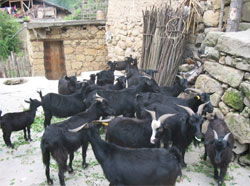
The villagers were interested in developing this area of animal husbandry. They wanted to utilise the vast amount of huangshan (cao chang) to plant grass and graze the animals and then sell them out. They also wanted to expand the number and quality of livestock they already had.
Every 3-5 households set up a collective group. DORS provided the village with a billy goat to improve the local species by breeding with local stock in each collective group.
Cement Path Project
With remaining funds leftover from initial project, the villagers voiced the need to improve existing village paths. Existing paths were dirt paths, which became very muddy in the rainy season. Walking was difficult especially for young children who had to walk to school. In winter months when daylight was short, some children would slip down the muddy path. An improved path would also be better for livestock and for water drainage away from houses.
Most of these project components were funded by Kadoorie Foundation 2001-2004.

